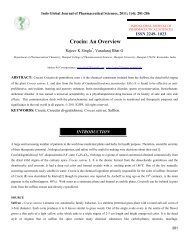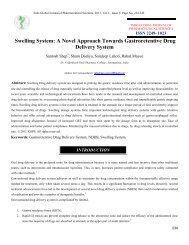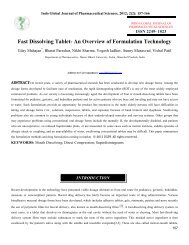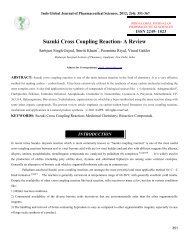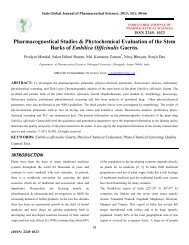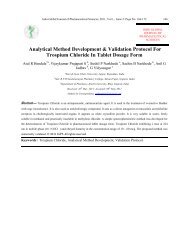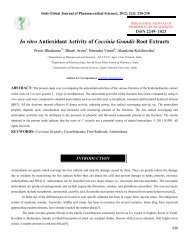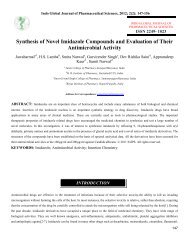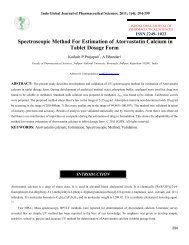Paramount Role of Solid Dispersion in Enhancement of Solubility
Paramount Role of Solid Dispersion in Enhancement of Solubility
Paramount Role of Solid Dispersion in Enhancement of Solubility
You also want an ePaper? Increase the reach of your titles
YUMPU automatically turns print PDFs into web optimized ePapers that Google loves.
Indo Global Journal <strong>of</strong> Pharmaceutical Sciences, 2013; 3(1): 78-89<br />
<strong>of</strong> many lipophilic substances, lead<strong>in</strong>g to an <strong>in</strong>crease <strong>in</strong><br />
properties. Polyoxyl 40 stearate has been used as an<br />
dissolution rate. [5]<br />
emulsify<strong>in</strong>g agent <strong>in</strong> <strong>in</strong>travenous <strong>in</strong>fusions. [5]<br />
Insoluble or enteric polymers<br />
Polyacrylates and polymethacrylates are glassy substances that<br />
are produced by polymerization <strong>of</strong> acrylic and methacrylic<br />
acid, and derivatives <strong>of</strong> these polymers such as esters amides<br />
and nitriles. They are mostly used <strong>in</strong> coat<strong>in</strong>gs to modify the<br />
release <strong>of</strong> the drug from the dosage form. Commonly they are<br />
referred by the trade name Eudragit. Polyacrylate is a<br />
chemical class <strong>of</strong> acrylate polymers derived from the<br />
polymerization <strong>of</strong> acrylic acid esters and salts. Each acrylate<br />
monomer conta<strong>in</strong>s a v<strong>in</strong>yl group, a pair <strong>of</strong> double-bonded<br />
carbon atoms attached to the carbon <strong>of</strong> a carboxyl group. Due<br />
to the high reactivity <strong>of</strong> carbon double bonds, acrylates<br />
polymerize readily and are used <strong>in</strong> a variety <strong>of</strong> plastics,<br />
adhesives and chemical b<strong>in</strong>der applications. These<br />
polyacrylates are transparent thermoplastic polymers that are<br />
physiologically harmless and readily soluble <strong>in</strong> organic<br />
solvents and are characterized by low resistance to oil and<br />
gasol<strong>in</strong>e. Polyacrylates are produced by polymerization <strong>of</strong><br />
esters <strong>of</strong> acrylic and methacrylic acids (acrylates and<br />
methacrylates, respectively). [6]<br />
Surfactants<br />
The polyoxyethylene stearates are a series <strong>of</strong> polyethoxylated<br />
derivatives <strong>of</strong> stearic acid. Polyoxyethylene stearates are<br />
nonionic surfactants produced by polyethoxylation <strong>of</strong> stearic<br />
acid. Two systems <strong>of</strong> nomenclature are used for these<br />
materials. The number ‘8’ <strong>in</strong> the names ‘poloxyl 8 stearate’ or<br />
‘polyoxyethylene 8 stearate’ refers to the approximate<br />
polymer length <strong>in</strong> oxyethylene units. The same material may<br />
also be designated ‘polyoxyethylene glycol 400 stearate’ or<br />
‘macrogol stearate 400’ <strong>in</strong> which case, the number ‘400’ refers<br />
to the average molecular weight <strong>of</strong> the polymer cha<strong>in</strong>.<br />
Polyoxyethylene stearates are generally used as emulsifiers <strong>in</strong><br />
oil-<strong>in</strong>-water- type creams and lotions. Their hydrophilicity or<br />
lipophilicity depends on the number <strong>of</strong> ethylene oxide units<br />
present: the larger the number, the greater the hydrophilic<br />
The poloxamer polyols are a series <strong>of</strong> closely related block<br />
copolymers <strong>of</strong> ethylene oxide and propylene oxide.<br />
Poloxamers are nonionic polyoxyethylene polyoxypropylene<br />
copolymers used primarily <strong>in</strong> pharmaceutical formulations as<br />
emulsify<strong>in</strong>g or solubiliz<strong>in</strong>g agents. The polyoxyethylene<br />
segment is hydrophilic while the polyoxypropylene segment is<br />
hydrophobic. [5]<br />
All <strong>of</strong> the poloxamers are chemically similar <strong>in</strong> composition,<br />
differ<strong>in</strong>g only <strong>in</strong> the relative amounts <strong>of</strong> propylene and<br />
ethylene oxides added dur<strong>in</strong>g manufacture. Their physical and<br />
surface-active properties vary over a wide range and a number<br />
<strong>of</strong> different types are commercially available. Poloxamers are<br />
used as emulsify<strong>in</strong>g agents <strong>in</strong> <strong>in</strong>travenous fat emulsions, and<br />
as solubiliz<strong>in</strong>g and stabiliz<strong>in</strong>g agents to ma<strong>in</strong>ta<strong>in</strong> the clarity <strong>of</strong><br />
elixirs and syrups. Poloxamers may also be used as wett<strong>in</strong>g<br />
agents <strong>in</strong> o<strong>in</strong>tments, suppository bases, gels etc. and also used<br />
as tablet b<strong>in</strong>ders and coat<strong>in</strong>gs. [5]<br />
Tweens (Polyethoxylated sorbitan esters) are ethoxylated<br />
spans. These are hydrophilic <strong>in</strong> nature and are soluble or<br />
dispersible <strong>in</strong> water and dilute solutions <strong>of</strong> electrolytes. The<br />
solubility <strong>of</strong> tweens <strong>in</strong> aqueous solutions <strong>in</strong>creases with degree<br />
<strong>of</strong> ethoxylation. For a fixed degree <strong>of</strong> ethoxylation, aqueous<br />
solubility decreases as the number <strong>of</strong> aster group<strong>in</strong>g <strong>in</strong>creases.<br />
[5]<br />
Spans (sorbitan esters) are a series <strong>of</strong> mixtures <strong>of</strong> partial esters<br />
<strong>of</strong> sorbitol and its mono and di anhydrides with fatty acids.<br />
Sorbitan diesters are a series <strong>of</strong> mixtures <strong>of</strong> partial esters <strong>of</strong><br />
sorbitol and its monoanhydride with fatty acids. These are<br />
nonionic surfactants and are produced by dehydration <strong>of</strong><br />
sorbitol. [5]<br />
Miscellaneous<br />
Urea is the end product <strong>of</strong> human prote<strong>in</strong> metabolism, has a<br />
light diuretic effect and is regarded as non-toxic. Its solubility<br />
<strong>in</strong> water is greater than 1 <strong>in</strong> 1 and it also exhibits good<br />
solubility <strong>in</strong> many common organic solvents. In one <strong>of</strong> the<br />
eISSN: 2249 1023<br />
84





